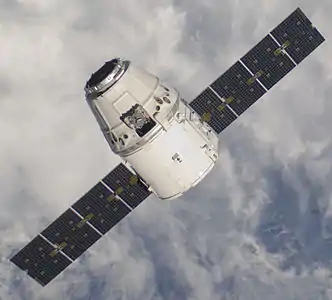SpaceX Crew-3
SpaceX Crew-3 will be the third crewed operational flight of a Crew Dragon spacecraft, and the fourth overall crewed orbital flight. The mission is currently planned for launch in September 2021.[2] At a NASA briefing held on 29 September 2020, Benji Reed, senior director of human spaceflight programs at SpaceX, said the final launch date for Crew-3 will be determined by the refurbishment of the Resilience capsule after Crew-1 recovery.[3][4] The Crew-3 mission will transport four members of the crew to the International Space Station. As of January 2021, three astronauts have been assigned to the mission; it has been speculated that the fourth crew member may be a Russian cosmonaut under a possible exchange agreement with Roscosmos.[1]
.jpg.webp) A previous flight of the capsule as it approaches the ISS. | |
| Mission type | ISS crew transport |
|---|---|
| Operator | SpaceX |
| Mission duration | 180 days (planned) |
| Spacecraft properties | |
| Spacecraft | Cargo Dragon C207 Resilience |
| Manufacturer | SpaceX |
| Launch mass | 6,000 kg (13,000 lb) |
| Landing mass | 3,000 kg (6,600 lb) |
| Crew | |
| Crew size | 4 |
| Members | Raja Chari (NASA) Thomas Marshburn (NASA) Matthias Maurer (ESA) TBA[1] |
| Start of mission | |
| Launch date | September 2021 (planned)[2] |
| Rocket | Falcon 9 Block 5 |
| Launch site | Kennedy Space Center, LC-39A |
| Contractor | SpaceX |
| End of mission | |
| Landing date | 2022 (planned) |
| Landing site | Atlantic Ocean |
| Orbital parameters | |
| Reference system | Geocentric orbit |
| Regime | Low Earth orbit |
| Inclination | 51.66° |
| Docking with ISS | |
| Undocking date | 2022 (planned) |
| Time docked | 180 days (planned) |
 Pictured from left are NASA astronaut Raja Chari, ESA (European Space Agency) astronaut Matthias Maurer, and NASA astronaut Tom Marshburn. | |
Crew
The mission will send up German ESA astronaut Matthias Maurer.[5][6][7] NASA astronauts Raja Chari and Thomas Marshburn were added on 14 December 2020 to the crew.[8][9]
| Position | Astronaut | |
|---|---|---|
| Spacecraft commander | First spaceflight | |
| Pilot | Third spaceflight | |
| Mission Specialist 1 | First spaceflight | |
| Mission Specialist 2 | TBA | |
| [1][6][8][9] | ||
A Crew-3 backup crew has not been announced.
| Position | Astronaut | |
|---|---|---|
| Spacecraft commander | TBA | |
| Pilot | TBA | |
| Mission Specialist 1 | TBA | |
| Mission Specialist 2 | TBA | |
Mission
The third SpaceX operational mission in the Commercial Crew Program is currently scheduled to launch in September 2021.[2]
The European segment of the mission is called "Cosmic Kiss".[10]
See also
- Dragon C206 Endeavour
- Dragon C207 Resilience
- Boeing CST-100 Starliner
References
- "NASA assigns astronauts for third SpaceX commercial crew mission". SpaceNews. 14 December 2020. Retrieved 21 December 2020.
- "NG-14 Cygnus departs ISS, kicks off busy year for Station crew". NASASpaceFlight.com. 6 January 2021. Retrieved 8 January 2021.
- Foust, Jeff (30 September 2020). "SpaceX has busy manifest of Dragon missions". SpaceNews. Retrieved 16 November 2020.
- Ralph, Eric (9 June 2020). "SpaceX wins NASA approval to launch astronauts on reused rockets and spacecraft". teslarati.com. Retrieved 16 November 2020.
- Brown, Mike (1 October 2020). "SpaceX and NASA Detail a Packed 12 months for Crew Dragon: What to Know". Inverse. Retrieved 16 November 2020.
- Becker, Joachim Wilhelm Josef (13 November 2020). "Spaceflight mission report: SpaceX Crew-3". Space Facts. Retrieved 16 November 2020.
- Manned Spaceflight Tweets [@MannedTweets] (8 September 2020). "ESA astronaut, Matthias Maurer, will fly on Crew-3 in October 2021" (Tweet) – via Twitter.
- Potter, Sean (14 December 2020). "NASA, ESA Choose Astronauts for SpaceX Crew-3 Mission to Space Station". NASA. Retrieved 14 December 2020.
 This article incorporates text from this source, which is in the public domain.
This article incorporates text from this source, which is in the public domain. - Clark, Stephen (29 December 2020). "Three astronauts assigned to Crew Dragon mission in late 2021". Spaceflight Now. Retrieved 29 December 2020.
- "ESA astronaut Matthias Maurer officially assigned first flight". esa.int. ESA. 14 December 2020. Retrieved 15 December 2020.



.jpg.webp)
